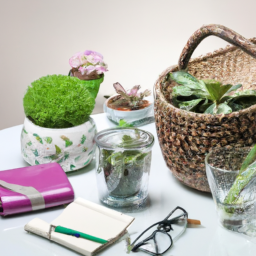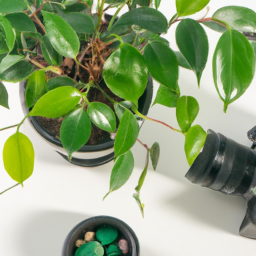
Are you on the hunt for the perfect indoor plants to add some greenery to your space? The search for indoor plants can be a fun and rewarding experience, but with so many options to choose from, it can also be a bit overwhelming. In this blog post, we’ll explore the world of indoor plants and provide you with some tips and tricks for finding the perfect plants for your home or office. Whether you’re a seasoned plant parent or a newbie looking to green up your space, we’ve got you covered. Let’s dive in and start searching for the perfect indoor plants to brighten up your space!
Benefits of Having Indoor Plants
Welcome to our guide on the benefits of having indoor plants! Indoor plants not only add beauty to your home or office space but also offer numerous health and wellness benefits. In this article, we will explore the various advantages of having indoor plants and how they can improve your overall well-being.
Improves Air Quality
One of the most well-known benefits of having indoor plants is their ability to improve air quality. Plants absorb carbon dioxide and release oxygen through the process of photosynthesis, which helps to purify the air in your indoor environment. In addition, plants can also remove harmful toxins such as formaldehyde, benzene, and trichloroethylene from the air, making it cleaner and healthier to breathe.
Studies have shown that indoor plants can significantly reduce indoor air pollution and improve overall air quality. By adding plants such as spider plants, peace lilies, and pothos to your indoor space, you can create a healthier environment for yourself and your family.
Furthermore, having indoor plants can also help to increase humidity levels in your home, which can be beneficial for your respiratory health, especially during the dry winter months. Plants release water vapor through a process called transpiration, which can help to combat dry air and reduce the risk of respiratory issues such as dry coughs and sore throats.
Boosts Mental Health
In addition to improving air quality, indoor plants can also have a positive impact on your mental health. Research has shown that being around plants can help to reduce stress, anxiety, and depression, and promote a sense of well-being and relaxation.
Plants have a calming effect on the mind and can help to create a peaceful and tranquil atmosphere in your home or office space. The act of caring for plants, such as watering them and pruning them, can also be therapeutic and provide a sense of purpose and accomplishment.
Furthermore, having indoor plants can help to increase productivity and creativity. Studies have shown that being in a green environment can boost cognitive function and improve concentration and memory. By adding plants to your indoor space, you can create a more inspiring and productive work or living environment.
Promotes Physical Health
Indoor plants not only benefit your mental health but also your physical health. Plants can help to reduce symptoms of allergies and asthma by purifying the air and removing allergens such as dust and mold spores.
In addition, being around plants can help to lower blood pressure and reduce the risk of certain health conditions such as heart disease and diabetes. Studies have shown that simply looking at plants can have a calming effect on the body and help to reduce stress and anxiety.
Furthermore, having indoor plants can also improve sleep quality. Plants release oxygen at night, which can help to create a more restful and relaxing sleeping environment. By placing plants such as lavender, jasmine, or aloe vera in your bedroom, you can promote better sleep and wake up feeling more refreshed and rejuvenated.

Best Indoor Plants for Low Light Environments
Understanding Low Light Environments
When it comes to choosing indoor plants for low light environments, it’s important to understand what exactly constitutes a low light environment. Low light environments are spaces that receive minimal natural sunlight, such as rooms with small windows or areas that are shaded by buildings or trees. In these environments, plants that thrive in low light conditions are your best bet for ensuring their growth and longevity.
One key factor to consider when selecting indoor plants for low light environments is the plant’s adaptability to low light conditions. Some plants have evolved to thrive in low light settings by being able to photosynthesize efficiently with minimal sunlight. These plants are typically shade-loving and can survive with just a few hours of indirect light each day. By choosing plants that are well-suited for low light environments, you can ensure that they will thrive and add beauty to your space.
Another important consideration when choosing indoor plants for low light environments is the level of maintenance required. Some plants are more resilient and can withstand periods of neglect, making them ideal for low light settings where consistent care may be challenging. By selecting low maintenance plants that can thrive in low light conditions, you can enjoy the benefits of indoor greenery without the stress of constant upkeep.
In addition to adaptability and maintenance requirements, it’s also important to consider the aesthetic appeal of indoor plants for low light environments. Choose plants that complement your existing decor and add a touch of greenery to your space. With the right selection of indoor plants, you can create a soothing and inviting atmosphere in low light environments.
Top Indoor Plants for Low Light Environments
1. Snake Plant: Also known as Mother-in-law’s Tongue, the snake plant is a popular choice for low light environments due to its hardy nature and ability to thrive with minimal sunlight. This plant features tall, upright leaves that add a touch of elegance to any space.
2. ZZ Plant: The ZZ plant is another excellent option for low light environments, as it can survive in almost any lighting conditions. This plant has glossy, dark green leaves that add a modern touch to your indoor space.
3. Pothos: Pothos is a versatile plant that can thrive in low light settings, making it a popular choice for indoor gardens. This plant features cascading vines with heart-shaped leaves that add a pop of green to any room.
4. Peace Lily: The peace lily is a classic indoor plant that thrives in low light environments. This plant produces beautiful white flowers and lush, dark green leaves, making it a stunning addition to any space.
5. Spider Plant: Spider plants are known for their air purifying qualities and ability to thrive in low light conditions. This plant features long, arching leaves with small plantlets that dangle from the mother plant, adding a unique touch to your indoor garden.
6. Cast Iron Plant: As the name suggests, the cast iron plant is extremely resilient and can survive in low light environments with minimal care. This plant features dark green, strappy leaves that add a touch of elegance to any room.
Tips for Caring for Indoor Plants in Low Light Environments
1. Rotate your plants: To ensure even growth, rotate your indoor plants every few weeks to expose all sides to the limited sunlight available in low light environments.
2. Monitor watering: In low light settings, plants may require less frequent watering due to slower growth rates. Be sure to check the soil moisture levels before watering to prevent overwatering.
3. Use artificial lighting: If natural light is limited, consider supplementing with artificial lighting to provide your indoor plants with the light they need to thrive in low light environments.
4. Choose the right potting mix: Select a well-draining potting mix for your indoor plants to prevent waterlogged soil, which can lead to root rot in low light conditions.
5. Keep an eye out for pests: In low light environments, plants may be more susceptible to pests such as spider mites and mealybugs. Regularly inspect your plants for signs of infestation and take appropriate measures to control pests.
By following these tips and selecting the right indoor plants for low light environments, you can create a lush and vibrant indoor garden that thrives in even the darkest corners of your home. Enjoy the beauty and benefits of indoor plants, no matter the lighting conditions.

Tips for Caring for Indoor Plants
Choosing the Right Plants
When searching for indoor plants, it’s important to consider the specific conditions of your home. Different plants have different light, humidity, and temperature requirements, so it’s essential to choose plants that will thrive in your space. Consider factors such as the amount of natural light your home receives, the humidity levels, and the average temperature. Some popular indoor plants that are relatively easy to care for include spider plants, pothos, and peace lilies.
Before purchasing any plants, do some research to determine which ones will be the best fit for your home. Look for plants that are known for their air-purifying qualities, such as snake plants and rubber plants. These plants can help improve the air quality in your home while adding a touch of greenery to your space.
When selecting plants, also consider the size of your space and the amount of time you can dedicate to plant care. Some plants require more frequent watering and maintenance than others, so choose plants that align with your lifestyle and schedule.
Providing the Right Environment
Once you’ve chosen the right plants for your home, it’s essential to provide them with the proper environment to thrive. Most indoor plants prefer bright, indirect light, so be sure to place them near a window where they can receive plenty of sunlight without being exposed to direct rays. If your home doesn’t receive much natural light, consider investing in a grow light to supplement your plants’ light needs.
In addition to light, indoor plants also require adequate humidity levels to thrive. To increase humidity around your plants, you can mist them regularly with a spray bottle or place a humidifier nearby. You can also group plants together to create a microclimate with higher humidity levels.
Proper watering is another crucial aspect of caring for indoor plants. Overwatering is one of the most common causes of plant death, so be sure to water your plants only when the top inch of soil feels dry to the touch. Use room temperature water and water your plants thoroughly, allowing excess water to drain out of the bottom of the pot.
Maintaining and Troubleshooting
In addition to providing the right environment for your indoor plants, it’s essential to regularly maintain and monitor them for any signs of trouble. Check your plants regularly for pests such as spider mites, mealybugs, and aphids, and treat them promptly if you notice any infestations. You can use insecticidal soap or neem oil to control pests naturally.
Regularly dusting your plants’ leaves with a damp cloth can help them photosynthesize more efficiently and prevent dust buildup, which can clog their pores and hinder growth. You can also prune your plants as needed to promote healthy growth and remove any dead or yellowing leaves.
If you notice any signs of stress in your plants, such as wilting, yellowing leaves, or stunted growth, take immediate action to address the issue. Adjusting the light levels, humidity, or watering frequency may help revive your plants and encourage new growth. Remember that caring for indoor plants is a learning process, so don’t be discouraged if you encounter challenges along the way.
Here’s the Summary Snapshot
Are you looking to add some greenery to your home but not sure where to start? Indoor plants are a great way to bring life and freshness into any space, whether it’s your living room, bedroom, or even your office. With so many options to choose from, it can be overwhelming to find the perfect plant for your space.
When searching for indoor plants, consider factors such as lighting, space, and maintenance. Some plants thrive in low light conditions, while others require bright, indirect sunlight. Additionally, think about the size of the plant and how much space you have available. If you’re new to plant care, opt for low-maintenance options like succulents or snake plants. With a little research and trial and error, you’ll find the perfect indoor plants to add a touch of nature to your home.
Frequently Asked Questions from our readers:
Q1. What are some popular indoor plants for beginners?
A1. Some popular indoor plants for beginners include pothos, spider plants, snake plants, and peace lilies. These plants are low-maintenance and can thrive in a variety of indoor environments.
Q2. How often should I water my indoor plants?
A2. The frequency of watering indoor plants depends on the type of plant, its size, and the environment it is in. As a general rule of thumb, most indoor plants should be watered when the top inch of soil feels dry to the touch.
Q3. What are some tips for caring for indoor plants?
A3. Some tips for caring for indoor plants include providing them with adequate sunlight, ensuring proper drainage in their pots, and regularly dusting their leaves to allow for better photosynthesis. It’s also important to monitor for pests and diseases regularly.
Q4. Can indoor plants help improve indoor air quality?
A4. Yes, indoor plants can help improve indoor air quality by absorbing carbon dioxide and releasing oxygen during photosynthesis. Some plants, such as peace lilies and spider plants, are also known for their air-purifying properties.
Q5. How can I choose the right indoor plants for my space?
A5. When choosing indoor plants for your space, consider factors such as the amount of sunlight your space receives, the size of the plants, and your level of commitment to caring for them. It’s also helpful to research specific plant care requirements to ensure they will thrive in your environment.
Dr. Olivia Green is a botanist with over two decades of experience in indoor plant cultivation. She holds a Ph.D. in Plant Biology and has dedicated her career to researching plant behavior in controlled environments. Dr. Green is passionate about helping plant enthusiasts master the art of indoor gardening through her extensive knowledge and practical insights.


